Man-controlled torpedoes of the Chariot family (UK)
By the time of the attack on the ships in Alexandria, the British command was aware of the existence of man-guided torpedoes. In October, the 41 th Italians attempted to sabotage the Strait of Gibraltar, but were defeated. One of the submerged torpedoes Maiale was raised to the surface and subjected to careful study. During the study of the torpedo it turned out that the enemy managed to create a simple but effective weaponwhich could be useful to the UK. Given the difficult situation at sea, the Royal Navy could resort to sabotage against enemy ships.
Task: copy
At the beginning of 1942, British engineers began working on promising projects of submarine technology for saboteurs. It was proposed two main ways of developing and developing such systems. One implied the construction of ultra-small submarines with the necessary equipment. This technique has received the symbol X-class. The second project was less complex and costly: it was proposed to copy the Italian SLC torpedo or, at a minimum, take it as a basis for its own project.
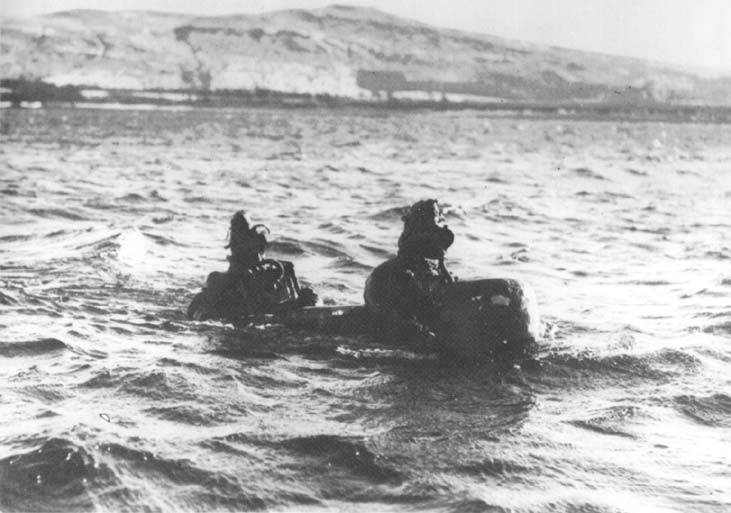
Torpedo Chariot Mk 1 on the water. Photo Bismarck-class.dk
Submarines of the project "X", by calculations, according to the characteristics should exceed the copy of Maiale. However, they were more difficult to manufacture, which should have affected the delivery time of equipment. As a result, it was decided to start with a human-guided torpedo, which the saboteurs could use for some time, until a more sophisticated technique entered service. The development of an English copy of the Italian underwater vehicle began in the first months of 1942. The project was named Chariot ("Chariot").
In the course of developing a new human-controlled torpedo, British engineers had to conduct several experiments. So, in April 1942 was built a wooden model of the underwater vehicle, nicknamed Cassidy. It was supposed to be used in test dives. Two testers, sitting on the layout, had to fill the ballast tank and descend to the required depth. The main objective of these tests was to test the proposed immersion systems.
During the tests a curious incident occurred. The first test dives were made in a small pool using a crane and ended without too much difficulty. Soon it was decided to test the Cassidy in the waters of the Portsmouth harbor, where problems manifested themselves. Even with a filled tank tank, the model did not want to sink to the required depth. As it turned out, the engineers did not take into account the difference in the density of fresh water from the pool and the salt from the harbor. After adding the right amount of lead cargo, Cassidy began to sink.
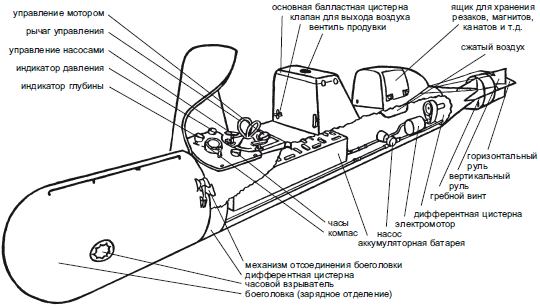
The scheme of the torpedo Chariot Mk 1
Upon completion of the test of the submersible layout, the Chariot project was finalized and completed, which allowed the construction of prototypes and serial equipment to begin. The first version of the "Chariot" received the additional designation Mk 1. In the future, the British designers presented another version of such a human-guided torpedo, which received the designation with a two.
Chariot Mk 1 design
The device Chariot Mk 1 was a modified version of the Italian torpedo SLC, which most directly affected its appearance. It had an elongated cylindrical body with a hemispherical head and conical tail fairing. Shields and other details of the crew workplaces were provided on the upper surface of the hull. The total length of the device was 6,8 m, case diameter - 88, see. The maximum height due to additional equipment reached 1,21 m.
The overall layout of the device Chariot Mk 1 was completely borrowed from Maiale. In addition, similar approaches to production were used: the basis for the “Chariot” was the aggregates of serial torpedoes that existed at that time. In the forward part of the body of the torpedo the warhead was provided In view of the intended method of use borrowed from the enemy, the warhead was installed on special locks. During the operation, it should be removed and left on the target ship.

Side view of the torpedo Chariot Mk 1. Figure Bismarck-class.dk
The batteries of the required capacity were located in the middle part of the hull, the electric motor and propellers in the stern. The screws were placed inside the annular channel. Behind them were the rudders of depth and direction. On the middle cylindrical section of the case there was additional equipment. Ahead, at the very fastenings of the warhead, there was a shield with instruments and controls for the driver. Behind the driver there was a squared ballast tank with control levers. Behind it was the second crew member, behind whom was a casing for additional equipment.
The equipment of two submariners-saboteurs was to consist of a wetsuit and breathing apparatus. The suit was made in the form of a rubberized fabric jumpsuit and covered the swimmer’s entire body, with the exception of the hands and face. As part of a closed-type breathing apparatus, a mask of one of the serial gas masks and a set of special equipment were used. On the straps and the belt of the breathing apparatus were attached two oxygen cylinders (on the back) and a special bag (on the chest). In addition, there was a lead ballast weight with fasteners for quick discharge. While working, the saboteur had to breathe oxygen from a breast bag connected to the cylinders. Exhaled gas flowed back into it, passing through a cartridge with an absorber of carbon dioxide. Used breathing apparatus allowed to work under water for a long time - up to 6 hours. During the work, he did not unmask the saboteur with bubbles floating to the surface.
Used batteries and an electric motor allowed the Chariot Mk 1 torpedo to move at speeds up to the 2,5 node. The design allowed to dive to a depth of 90 feet (27,5 m). The duration of swimming reached 5 hours and was mainly limited by the capacity of the oxygen cylinders of the breathing apparatus. The range of navigation, in turn, depended on the current and other external factors. For this reason, when planning operations, it was necessary to take into account the peculiarities of the water area and, accordingly, determine the landing point of the saboteurs.
Carriers were invited to make the existing surface ships and submarines, the latter were considered the most promising means of delivery. Such equipment could secretly vyh in the area of the goal and make the landing of man-controlled torpedoes, whose task was to destroy these goals. In developing a way to deliver torpedoes to the target, British engineers faced the same problems as their Italian counterparts a few years ago. The SLC and Chariot Mk 1 torpedo hulls were not very durable, so they could not be lowered to great depths.
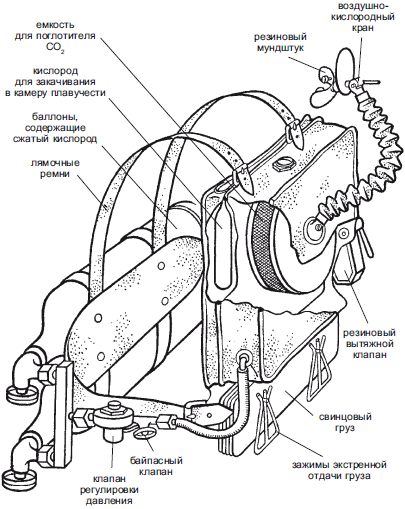
Breathing apparatus
For this reason, both the Italians and the British decided to transport torpedoes in special containers. For the transport of the Chariots, the Mk 1 was offered a special container with a length of 7,4 m, a width (inside) of 1,25 m and a height of 1,65 m. The internal equipment of the container allowed filling the cylinders with compressed air installed on the torpedo, ventilate the battery compartment and charge the batteries. Inside the container, the torpedo was on a special trolley and secured with a set of lines. In addition, in front of the container on the deck of the submarine carrier, special rails should be installed to put the torpedo out before leaving the mission.
The proposed method of application was as follows. The submarine was supposed to deliver several torpedoes of the Chariot Mk 1 to the area where the target was located. The saboteurs received instructions, put on wetsuits and breathing apparatus, and then left the submarine. After that, they should open the container with their apparatus, bring it to the deck, start the engine and follow the target. If necessary, saboteurs could emerge to a shallow depth and specify their location. However, they had to rely on a compass, depth gauge and other instruments on most of the route and on the target.
The method of installation of the warhead was completely borrowed from the Italian project. Reaching the target ship, the saboteurs had to install special clamps on their side keels. The clamps were interconnected by a cable, on which the detachable torpedo warhead was suspended. Next, the divers could set the fuse of the warhead at the right time and leave the sabotage site. Having mined the ship of the enemy, they had to return to the indicated point of evacuation.
The serial production of human-controlled torpedoes Chariot Mk 1 started in the summer of 1942. This technique was not a priority, because of what was not built in large quantities. In just a few months, the Royal Navy received just the 34 “Chariots” of the first model. Most of this equipment later took part in several combat operations.
A little later, the second version of the British human-guided torpedo appeared under the designation Mk 2. From the basic version it differed in size and some characteristics. The new project used the experience gained in the testing and training of the "Chariots" of the first version. Available information led to some changes in the project, which should have affected the overall combat effectiveness of torpedoes.
The Chariot Mk 2 was larger and heavier than its predecessor. Its length reached 9,3 m, the diameter of the hull was 80 cm, the maximum height (for equipment on the top surface) exceeded 1 m. Due to the increase in length, it was possible to enter the places of two crew members inside the hull. They were supposed to fall into place through round holes in the upper part of the body. The driver, as before, was located on the front of the hull, while the second saboteur had to sit with his back forward. Weight in combat position increased to 5200 pounds (2360 kg). By increasing the space for rechargeable batteries, a more powerful engine and other features, the maximum speed increased to 4,5 knots. The battery capacity allowed you to move at maximum speed for 5-6 hours, which gave significant advantages over both Italian and existing British technology for a similar purpose. For several months, British shipbuilding enterprises built and transferred the fleet three dozen torpedoes of the second model.
Combat application
By the fall of 1942, the Royal Navy had several dozen new human-controlled torpedoes. The command decided to use the new technology in the near future. Soon a plan of operation appeared under the code name "Norway". The first goal of the "Chariots" was to be the German battleship Tirpitz, who was in one of the Norwegian fjords. The destruction of the enemy ship was scheduled for November 1.
October 26 one of the British ports left the trawler Arthur. Leif Larsen, one of the most famous and successful commanders of the Royal Norwegian Navy, was appointed captain of the ship. In the hold of the trawler there were three human-guided torpedoes. Two of them were planned to be used in the operation, another was considered as a reserve. On the way to the Trondheim Fjord, where, according to intelligence, there was a "Tirpitz", the saboteurs launched two torpedoes into the water. Their crews have taken their places. To the place of the beginning of the combat work torpedoes were to be reached in tow.
Captain Larsen managed to successfully pass all German patrols and enter the right fjord. However, after passing less than 10 miles, the sailors noticed that both towing cables were broken. Due to strong excitement, two man-controlled torpedoes broke down and were smashed. Of the four saboteurs, three were missing and probably died. Only Bob Evans from the crew of the second "Chariot", injured, managed to reach the shore. He was found by the Germans and captured. In order not to betray his comrades, Evans, taking advantage of the moment, shot himself.
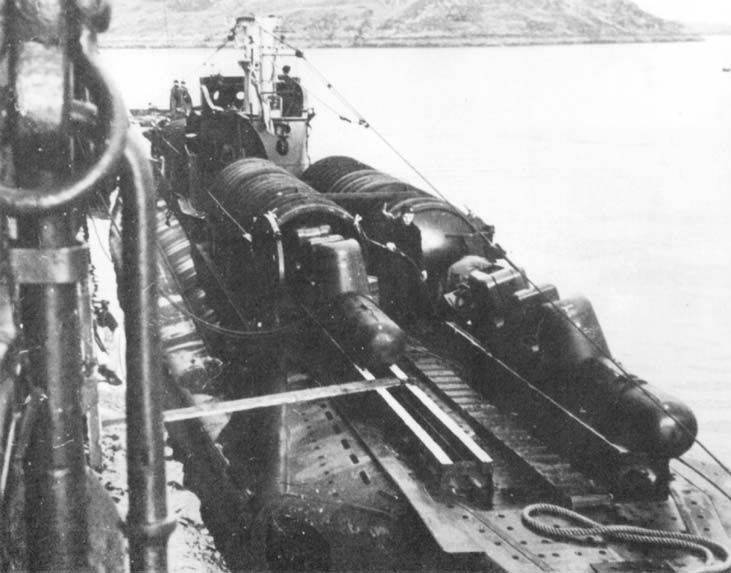
Containers with torpedoes Chariot Mk 1 on the deck of a submarine. Photo Bismarck-class.dk
During the first operation, the Royal Navy of Great Britain lost two Chariot Mk 1 vehicles and four saboteurs who could not fulfill their task. Nevertheless, experience was gained: it became clear to everyone that surface ships could not be convenient and effective carriers of human-controlled torpedoes.
On 2 January, 1943 was scheduled for an operation off the coast of Palermo in Italy. On this day, the Italian development, adapted to the capabilities of the British industry, was to strike at the fleet of Italy. By this time, several submarines became torpedo carriers. The HMS Trooper submarine received three containers for the "Chariot", and on the HMS Thunderbolt and HMS P311 mounted on two. The fourth torpedo carrier was the HMS Traveler boat, however it was destroyed on December 4 1942 of the year, one month before the operation.
During the January 2 operation, the HMS P311 submarine was discovered by the Italian fleet and attacked. The British failed to escape from prosecution, the submarine died. For this reason, of the seven torpedoes, only five participated in the operation. It seemed that this number of devices was enough to perform a combat mission, but the operation was finally considered unsuccessful.
The crew consisting of officers Stevens and Carter, launched from the submarine HMS Trooper, was unable to complete his task. For five hours they tried to find the entrance to the desired harbor, after which Carter ran out of oxygen. Stevens left him on the surface, on the buoy, and then continued the task. Alone, he could not find the target and returned to his comrade. They could not find their submarine carrier, but the crew of the ship HMS Unruffled came to the rescue. Saboteurs noticed and raised on board.
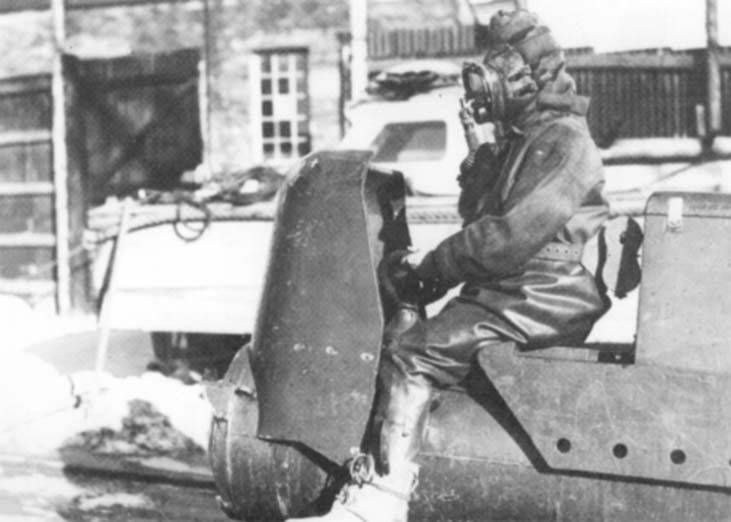
The pilot of the torpedo Chariot Mk 1. Warhead undocked. Photo Bismarck-class.dk
On the second "Chariot" there was a battery explosion. Commander W. Simpson drowned, and J. Milne was captured. Also captured was the crew of the third torpedo. Her commander, Cook, seriously damaged his suit and could not continue to work. His colleague G. Worthy decided to take the commander to the shore and continue the task alone. He could not independently produce all the necessary procedures, decided to return for the commander, pick him up and go to the submarine. On the shore, he did not find Cook and later captured.
Two pairs of saboteurs were able to reach their targets and set charges. One torpedo was ruled by R. Greenland and A. Ferrier, the second by R. Dove and J. Friel. Greenland and Ferrier mined the Italian cruiser Ulpio Traiano. Dove and Friel installed a mine in the aft part of the Viminale transport with a 8500 tonnage. Both vessels were seriously damaged by the explosions. Four saboteurs, in turn, were captured. Dove and Friel were forced to go ashore due to torpedo problems, and Greenland and Ferier damaged the compass during the voyage and were stuck in the anti-submarine network, and then surfaced.
On the night of January 18 1943, the submarine HMS Thunderbolt went to Tripoli with two Chariot Mk 1 vehicles on board. One of the torpedoes could not complete the task. About half an hour after leaving the submarine carrier, having almost reached the bay, J. Larkin and K. Barrey noticed damage to the immersion system, which did not allow them to continue working. The saboteurs reached the coast, destroyed the torpedoes and equipment, and then went home. For seven days they experienced a lot of adventures: the Germans took them prisoner, the Italians found them, etc. Divers were able to get to Cairo, where they went to Malta, to their base.
The crew of Stevens and S. Buxton was unable to perform the main task and headed for the alternate target, which he successfully destroyed. Later they were captured and sent to prison camp. After several transfers, they were sent to a camp near Rome, where Greenland and Dove were already located. In the early autumn of 1943, the saboteurs took advantage of the confusion associated with the surrender of Italy and fled the camp. Soon, they took refuge in the Vatican, where they remained until the complete liberation of Italy by Allied troops.
According to the results of the first operations, it was decided to use new media. Submarines T-class were too large to participate in some operations. For this reason, it was decided to install the "Chariot" containers on U-class submarines. The necessary equipment, including one container each, received the submarines HMS Unrivalled, HMS Unseen and HMS Unison. In addition, the possibility of towing various ships and boats.
21 June 1944, the chariot crews carried out one of the most successful operations. With the assistance of the Italian allies who had previously served in the 10 fleet of the MAS, British saboteurs reached the city of Spezia and set off for the target - the heavy cruiser Bolzano with a total displacement of 14,6 thousand tons. Previously, this ship belonged to the Italian Navy, but after the surrender went to the Germans. A few hours after the departure of the saboteurs, the ship went to the bottom. The crew of K. Barey and S. Lawrence could not find the entrance to the bay. M. Cowser and G. Smith successfully reached the target and set a mine. Unable to find the tugboat, the saboteurs were forced to go ashore. Some divers were captured, others joined the partisans.
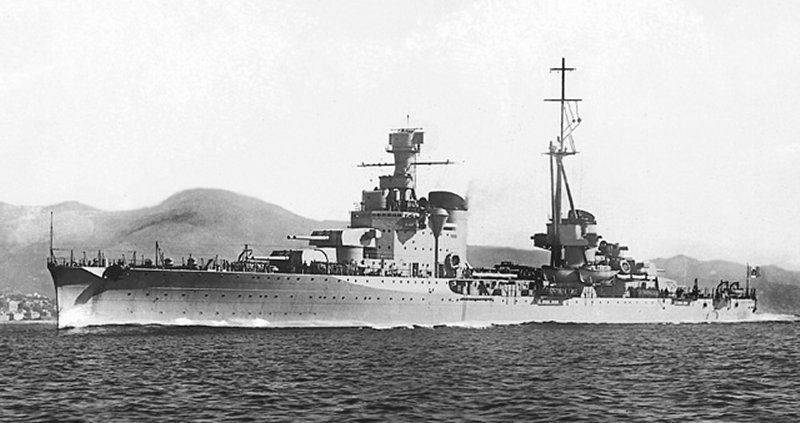
Cruiser Bolzano. Photos Warshipsww2.eu
The only operation involving Chariot Mk 2 was performed on 27 on October 1944 of the year. It is noteworthy that this time the British submariners had to go to the shores of Southeast Asia. The submarine HMS Trenchant delivered to the city of Phuket (Thailand) two man-guided torpedoes. The crew of Eldridge and Walcott was to mine the Italian ship Sumatra, the task of Smith and S. Brown was to destroy the ship Volpi.
The first crew of the "Chariot" successfully got to the target, set the charge and returned to the submarine carrier. Eldridge and Walcott faced serious problems. The bottom of their goal has not been cleaned for a long time, because of which the saboteurs could not install the charge in the right place. They had to spend 20 extra minutes to place the torpedo's warhead near the engine room.
Both couples of saboteurs successfully returned to HMS Trenchant and soon personally watched the explosions. During this operation, the Royal Navy suffered no losses, and the enemy lost two ships at once.
Results
In the future, British saboteurs were unable to repeat the success of 27 October 44 th. This was the last operation involving the Chariot torpedoes. The situation in the maritime theaters of war, on which Great Britain fought, was changing in its favor. The need to use special sabotage equipment was absent. In five operations, the saboteurs managed to sink or damage less than a dozen enemy ships and ships. Died 16 divers. 21 man has been honored with various awards.
After the end of the war in Europe, the operation of the Chariot torpedoes continued. Despite the lack of combat missions, this technique was involved in the search and disposal of sea mines from various areas of the European coast. In these works, the "Chariots" were used as a vehicle for divers-miners. Soon after the completion of coastal clearance, all human-guided torpedoes were decommissioned and disposed of. Chariot devices have been replaced by newer and more advanced systems.
Based on:
http://samilitaryhistory.org/
http://militarydiver.proboards.com/
http://bismarck-class.dk/
http://navypedia.org/
http://warshipsww2.eu/
Warren C., Benson D. Waves above us. - M .: ZAO Tsentrpoligraf, 2004
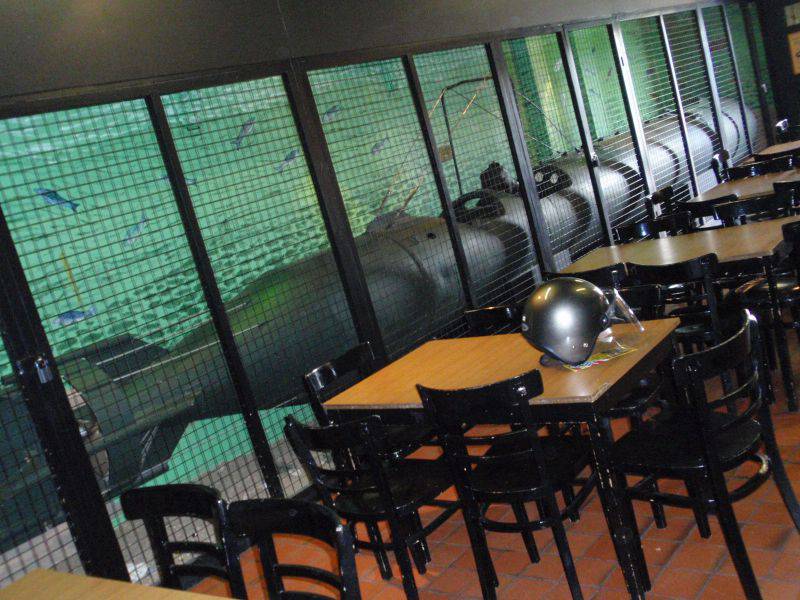
Information